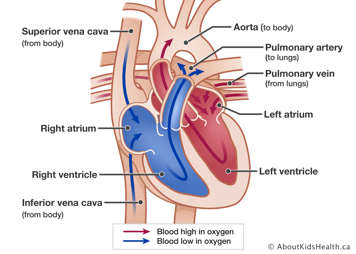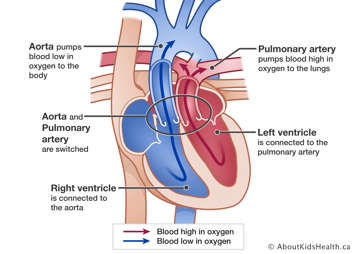What is transposition of the great arteries (TGA)?
Complete transposition of the great arteries (TGA) is a rare congenital heart defect. Congenital means a person is born with the condition. It's a common reason for a newborn to have heart surgery.
In a noraml heart, the blood low in oxygen comes from the body, back to the heart’s right side. It's then pumped through the pulmonary artery to the lungs where it "reloads" oxygen. Blood then goes from the lungs to the left side of the heart to be pumped to the body through the aorta. This way oxygen is distributed to the whole body.

In people born with TGA, the two main arteries (the great arteries) that are connected to the heart are switched (transposed).
- The aorta is connected to the right ventricle instead of the left ventricle.
- The pulmonary artery is connected to the left ventricle instead of the right ventricle.

This switch of the great arteries means that blood that is low in oxygen gets pumped around the body instead of blood that is high in oxygen. An open-heart surgery called the arterial switch operation is needed to fix this problem with the heart's arteries.
Some patients with TGA may also have other heart problems, such as a ventricular septal defect (VSD), abnormal coronary arteries (blood vessels that carry blood and oxygen into the heart muscle) or pulmonary stenosis.
How is TGA diagnosed?
TGA can sometimes be detected during pregnancy by routine ultrasound. After birth, if a baby appears blue (cyanotic) and has low oxygen saturations, doctors may suspect they have TGA. An echocardiogram (heart ultrasound) is done to confirm the diagnosis. A chest X-ray and electrocardiogram (ECG) are also commonly performed.
How is TGA treated?
Most cases of TGA are treated with procedures called balloon atrial septostomy and an arterial switch operation. These procedures usually happen when you’re a baby.
Complications of the arterial switch
Although the arterial switch is major heart surgery, it is a very successful operation. However, some complications can occur. TGA is a lifelong condition so it’s important to keep seeing your cardiologist. Many complications can be diagnosed before you develop symptoms.
Pulmonary artery and branch pulmonary artery narrowing
In a small number of children, the main pulmonary artery or the branch pulmonary arteries may become narrow. Sometimes an intervention called a balloon dilation is needed to enlarge the narrowed section and, rarely, a stent (small metal tube) is required to widen the narrowed section by supporting the walls of the blood vessel or conduit to keep it open. If this is not successful, another operation may be required.
Coronary artery problems
Much more rarely, a problem with a coronary artery, which was moved at the time of the arterial switch operation, may develop. A CT scan or cardiac catheterization may be needed to diagnose this problem.
Dilation of the aorta and leaky aortic valve
Sometimes the aorta can dilate (become larger) at the site where it was reattached to the left ventricle. This can be diagnosed by regular follow up with your cardiologist. Similarly, a leaky aortic valve can be diagnosed before symptoms develop.
Can patients with a repaired TGA exercise normally?
Children who had surgery for TGA are expected to grow and be able to exercise normally. In the past patients with congenital heart disease were often told not to exercise, or to push too hard during exercise as the heart was weak. However, this is not true and regular exercise is beneficial. People with repaired TGA can usually participate in all sporting activities without restrictions. If this is not the case, your cardiologist will let you know.
Pregnancy and sexual health after TGA repair
For most individuals who had a repair of their TGA with an arterial switch operation pregnancy is safe. However, every pregnancy has some risks that can be increased in people with congenital heart disease. This is why it’s important to talk to your cardiologist before trying to get pregnant, as unplanned pregnancies should be avoided. This is something your cardiologist, transition nurse or primary care provider can help with.
Who can I speak to about contraception?
If you have a repaired TGA, you should use contraception before you become sexually active. Your cardiologist, transition nurse or family doctor are the best people to talk to about contraception as they will know a lot about your heart condition.
Online resources such as http://www.iheartchange.org are also available.
What method of contraception is recommended?
In general, people with repaired TGA can use any form of contraception.
The Canadian Paediatric Society recommends long-acting reversible contraceptives (LARCs) as the preferred contraceptive of choice for all teens and young adults in Canada, as they are the most effective. One of the reasons they are so effective is that you do not need to remember to take a pill every day. LARCs, come in the form of subdermal (under the skin) implants and intrauterine contraceptives (IUCs) and are substantially more effective when used properly than hormonal contraceptives such as 'the pill'. LARCs are safe for women with TGA.LARCs have to be inserted by a doctor who is trained in the procedure and are typically effective for 3 years. Usually, in women with repaired TGA this procedure does not have to be performed at a hospital and can be performed in a community health clinic.
Though a LARC is the most recommended form of contraception, alternative contraception options are also available. The combined oral contraceptive pill (‘the pill’) or the progesterone only pill (‘the mini pill”) are generally safe for women with repaired TGA.
Regardless of contraception choice, a condom should always be used to reduce the risk for sexually transmitted infections (STIs) and once sexually active, regular STI testing is recommended. It’s important for both partners to practise safe sex – it’s not just one person’s responsibility.
Emergency contraception such as 'the morning after pill' or 'Plan B' is safe for women with TGA.
Family history and CHD
The risk for any person having a baby with congenital heart disease is about 1%. Babies born to a parent who has congenital heart disease, such as an TGA, the chance that the baby will have any type of congenital heart disease is about 3%. This risk is for both men and women. That still means there is a 97% chance that the baby will not have congenital heart disease.
People with congenital heart disease can talk with a genetic counselor or genetic specialist before deciding to have children. A special ultrasound scan of the fetus’s heart can be performed during the pregnancy to look for congenital heart disease.






